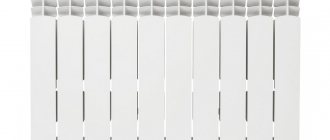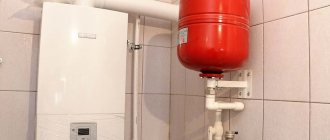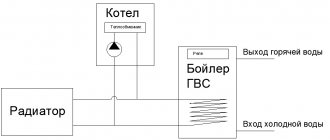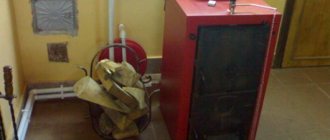If in conventional storage water heaters the water temperature increases due to the operation of heating elements, then in boilers heating is carried out by circulating coolant in the system. That is, the liquid is heated in the boiler and supplied through pipes to a coil or other heat exchanger installed in the tank. At the same time, cold water enters the tank from the central line, which is subsequently heated by heat exchange through the walls of the coil. This system will allow you to forget forever about problems with the lack of hot water.
Indirect heating boiler tank size
The tank volume is selected in the same way as when choosing an electric storage boiler. The main factor is the number of active users, i.e. residents in an apartment or house.
For example, if such a boiler is needed only to provide the kitchen with hot water, then the best option would be to use a 30-liter tank. This is quite enough to wash the dishes or wash your face, if necessary.
In order for 1-2 people to take a shower, you need to use a tank with a volume of at least 50 liters, 60-80 liters would be optimal for two people.
If there are more active users, or you want to take a full bath, then you need to select a tank with a volume of 100 to 120 liters. This is enough to take a hot bath.
Gas heating equipment + BKN
At a dacha for a summer holiday it is not necessary to install a complex communications system, whereas for a cottage of permanent residence it is simply necessary. There is no point in wondering whether an additional boiler is needed for a gas boiler - of course, it will turn out to be a very useful acquisition, significantly increasing the comfort of living in the house.
We will review the basic BKN connection diagrams in order to prevent errors that are possible when installing the equipment yourself.
Connection diagram to a 1-circuit boiler
Single-circuit units perform one of the functions declared by the manufacturer: either provide water heating for hot water supply, or heat the house - and the second option is used much more often in everyday life.
The combined solution - a 1-circuit gas boiler + BKN - is one of the best for a small cottage.
Connection diagram of BKN to a gas boiler. Heating of water for heating and hot water supply occurs synchronously, after which it is distributed into two branches - to the heating radiators and the boiler
The heating process occurs according to the following scheme:
- cold water enters the boiler, where it is heated to the required temperature (for example, +80°C) by a gas burner;
- the heated coolant enters the heating circuit - to the radiators - and into the heat exchanger of the storage water heater, i.e. boiler;
- By increasing the temperature of the heat exchanger, the water in the boiler is heated and when the water taps are turned on, it flows to the consumer.
When implementing this scheme of a gas 1-circuit boiler with an indirect boiler, the main importance is the technical data - power and coolant supply rate.
According to average indicators, the water in the boiler, if it has not previously functioned, heats up from zero to an acceptable temperature in 5-15 minutes, that is, the wait will not last long. Usually the unit is in working condition, so there is always access to heated water.
Let's look at the features of the strapping of the devices in question.
First, you need to choose the most convenient installation location - most often it is a boiler room, a separate non-residential premises. It is better to place the units at a close distance from each other - this way the heating process occurs faster, and less materials are consumed.
Floor mounting requires installation in such a way that the distance to the nearest obstacles or devices is at least 0.5 m - this will be required for maintenance or inspection of the unit
The piping occurs on two sides: loading and water supply.
At the outlet of the boiler, it is recommended to install a membrane expansion tank, which compensates for thermal expansion and stabilizes the operation of the system. All circuits must be equipped with ball valves and check valves that regulate the direction of coolant flows.
It would not be superfluous to install filters - the water supplied to the system is different, and during an accident sand or other debris can get in, which can contaminate the coolant and damage the equipment.
A mandatory element is a circular pump that supplies water at the required pressure. It is mounted on a pipe between the boiler and the boiler, and it is controlled in one of the following ways: either by a storage thermostat, or by a temperature sensor in the boiler
Shut-off valves are installed on both sides of the pump. The same tap is at the cold water inlet to the boiler.
A tee with a drain valve is installed on the boiler pipe, and shut-off valves are installed on both pipes so that the unit can always be cut off from the boiler for cleaning or other maintenance. On the supply, in front of the shut-off valve, you need to place an air vent.
The best option is to connect using a three-way thermostatic valve, which organizes the coolant exiting the boiler and dividing it into two flows - into the boiler and the heating sector. With its help, you can regulate the temperature: if heating up to + 80-90 ° C is suitable for radiators, then for heated floors it is better to limit it to + 45 ° C.
If there is no three-way valve, then two circulation pumps are installed, one of which serves the BKN, the other is intended for the heating branch.
Diagram of connecting the boiler to the solar system. Interaction with the solar collector requires the installation of a separate closed circuit with a heat exchanger and temperature sensors
Sometimes circuits with coolant recirculation are used - for example, to constantly maintain a heated towel rail in “working” condition. Heated water circulates in a closed circuit, preventing the pipe from cooling. A circulation pump is a mandatory element, but a check valve is not needed. The disadvantage of such a system in the summer is excessive energy consumption.
When the operation of the gas boiler switches to “summer mode,” the heating circuit is simply cut off - the gas burner heats the coolant for the boiler. But there is another way out - simply turn off the gas boiler and use only the boiler. This is possible if the storage device is additionally equipped with an autonomous heating source - a heating element.
Two application options with a 2-circuit boiler
Owners of gas heating equipment are also interested in how an indirect heating boiler with a 2-circuit gas boiler works. Experts believe that interaction between the units is possible, but the result depends on the connection diagram: with one of them they are simply not designed to work with each other.
Introduction of a boiler into the DHW circuit
First, let's consider the option when the boiler is integrated into the DHW circuit. From a hydraulic point of view everything looks correct. A three-contact mechanical thermostat, placed in the boiler body, closes the power supply circuit to the pump when the temperature drops.
That, in turn, begins to pump water, which circulates along the circuit between two heat exchangers: it is heated by a gas burner, and then moves to the BKN coil.
Simply put, both devices perform their functions: the boiler stops heating and begins to heat water for hot water supply, and the boiler tries to heat the contents of its “storage” due to the increased temperature of the hot water.
The problem arises precisely because of the mismatch of temperature parameters. Let's assume that the initial filling temperature of the boiler is +15˚С, and the recommended temperature for heating water in the boiler is +60˚С - the automatic limiter no longer allows.
The difference between the two set parameters of 45˚ is significant, so the heat exchange in the boiler occurs quite intensively. But the temperature begins to rise, and when it reaches +40˚С, the difference is much smaller - only 20˚. Accordingly, heat transfer slows down.
Don't forget that water continues to circulate between the two devices. The gas burner of the boiler begins to receive not a 15-degree coolant from the cold water system, as recommended by the manufacturer, but a 40- and then 50-degree heated liquid from the boiler.
As a result, the temperature of the liquid instantly soars to +60˚С, the sensor is triggered, the burner turns off, as it is programmed for parameters that are safe for consumers
The water in the boiler begins to cool - the sensor turns on again and the circulation process resumes. And so on all the time. This leads to the fact that the water in the boiler does not reach the required temperature, but remains insufficiently hot, which is not suitable for domestic hot water use.
The process of interaction between the two units could take place if the boiler burner heated the coolant to +80˚C, but this is prohibited by the instructions to protect users from burns.
Another reason not to use the BKN and DHW circuit of a gas boiler in steam lies in the inability to heat the water in the boiler to a temperature exceeding +60˚C. This is due to sanitary standards.
About once a week, the device is filled with hot water at about 70-75˚C, so that the legionella bacterium, whose colonies resemble mucus, does not multiply in the tank. A large number of bacteria in water leads to the development of allergies and other diseases
It can be concluded that due to only two, but significant reasons, the scheme of combining a gas boiler and BKN through a hot water supply circuit was recognized as ineffective and unsafe. If you already have a double-circuit boiler, just use it for its intended purpose: use one circuit for the heating system, the second for DHW.
Interaction of BKN with the heating circuit
The second option is the interaction of the BKN with the heating circuit. The technical solution works great if the performance of the gas boiler is not enough, and this is the only effective way to connect the BKN to a 2-circuit boiler.
We do not touch the hot water circuit, but use only the branch responsible for heating - that is, going to the radiators and the “warm floor” system. The pipe leading to the boiler must be connected immediately under the boiler, after the tap
With electronic control, you need to set the boiler to heat water at +70°C - this is the coolant that will flow into the boiler, where further temperature adjustment will take place. The thermostat located in the boiler will turn on the pump when the temperature drops, and turn it off when the required value is reached.
With mechanical control of a gas boiler, everything happens differently. A second thermostat, the boiler, is connected to the boiler thermostat, and then the first device can be controlled using the second. For example, if you set the temperature on the second one to +80°C, then the first one, the worker, will require heating the water to +80°C, regardless of what temperature it is set to.
When the water in the boiler heats up to the required temperature, the second thermostat breaks the circuit, and the first one, located on the boiler, again becomes the “main” thermostat. If at this moment the temperature is set to +40°C, then it will drop to 40.
Instantaneous water heater power
As in the previous paragraph, here too everything is similar to an electric water heater. Initially, you need to find out the capabilities of the electrical network in your house or apartment, and then select the optimal value.
However, in addition to the power of the heater itself, the power of the connected boiler or central heating, which will heat the coolants, also plays a role. The temperature of the coolant in the heating system is also taken into account if a connection to central heating is used.
How does a gas instantaneous boiler work?
All the main elements of a gas instantaneous boiler are mounted inside a durable metal casing. The water coming from the water supply line passes into the heat exchanger, under which the gas burner is located. The device is quite simple at first glance, but in order for the gas heater to work without accidents, the entire system must be equipped with rather complex automatic devices.
Immediately after you open the hot water tap, a valve opens in the boiler automation, which opens the gas supply. In good models, the incoming gas is ignited automatically, but in more modest ones you will have to press a special button.
The combustion of natural gas produces combustion products that are removed through the chimney. There are options for gas boilers with closed combustion chambers, in which combustion products are removed through a metal coaxial hose.
As a rule, gas heaters are installed in houses connected to main gas supply systems. They are certainly the leaders in terms of price-quality ratio under such conditions. Gas instantaneous boilers have rather modest dimensions. The low cost of gas consumed to heat water allows them to be called a successful economical option. Thus, the cost of heating water in such a device is approximately three times lower than in its electric counterpart. Apparently as a result of this, and also because of the need to supply such devices with reliable automation, the cost of the gas water heater itself is higher than that of an electric boiler.
A gas instantaneous boiler recommended for installation in an apartment can supply up to 17 liters of hot water per minute to the tap.
Solar heating boilers
Despite the general severity of the Russian climate, solar water heaters have recently been steadily increasing the number of sales. This is due primarily to the fact that such a device has virtually no operating costs. Once you invest in a solar heating system, you can forget about the costs for several decades. Modern devices allow high-quality heat accumulation, heating water and keeping it in a heated state for quite a long time. However, the choice of such a device must be approached very carefully, because not every solar heater will work well even in sunny days in the harsh winter Russian climate.
As a rule, to complete a private house, it is recommended to install a solar collector with a storage tank with a capacity of 300 liters. Hot water will be supplied to such a tank by two collectors. It can be used not only for household purposes, but also, for example, for heating water in a swimming pool.
The operating principle of such a device is quite simple: pipelines with flowing water are placed in special transparent containers filled with either a heat-absorbing substance or simply a vacuum.
Construction type
There are several main types of structures that are in demand:
- Tubular type coil. This variety is further divided into 2 subspecies. One coil is used in standard format boilers, two coils are used in indirect heating boilers connected to boilers or central heating.
- System of connected tanks. This system involves placing tanks inside each other; they are of different diameters, and are usually made of stainless steel. Water is poured into the internal tank, which will need to be heated. Coolant is poured into the external tank, through which heating will occur.
Operating principle of an electric storage water heater
Equipment of this type operates according to a special principle. The water is mixed inside the storage heater. According to the laws of physics, the warmer liquid rushes up the reservoir. Cold or less heated water accumulates at the bottom; this is the heating zone where the heating element operates. Passive fluid shear ensures periodic activation of the equipment, that is, heating until ready.
For your information! The device has a permanent connection to the network. The load on the heating equipment is controlled through thermostat contacts. Their task is to open the circuit when the water reaches the required degree of heating.
To block inversion (recirculation), a check valve operates in the equipment system. It is this that prevents the heated water from moving in a different direction. Water distribution fittings operate on the outlet line (to the consumer). After distribution by the pipe, the pressure inside the boiler system decreases. The response to this is to open the fill valve to fill the tank with cold water from the tap.
Note! The divider is of decisive importance for the efficiency of an electric water heater. It controls the water mixing process by limiting the speed
Material
The material used in the manufacture of the tank is of great importance. Currently there are 3 varieties.
Enameled tank
It is very popular due to its availability and low cost.
- May contain silver ions, but they make sense as a disinfecting element only if the design involves the use of coils.
- Otherwise, they will be useless, since the inner surface of the enameled tank will not come into contact with sanitary water, which will be used for washing.
- This material is relatively protected from corrosion, but it can still occur.
Welding seams are the most vulnerable, since they, as a rule, are not treated with a special compound, so the spread of rust often begins from them.
Stainless steel
This option is more reliable compared to the previous one, but it is more expensive and weighs a little more. However, it is also in high demand.
- It is perfectly protected from corrosion, which allows you to completely protect the structure from rust.
- Welding seams, as a rule, are also not processed, as in the previous version, so special attention is required for them.
Titanium coating
The most expensive material used to make a water heater tank. It is much better than stainless steel, stronger and more resistant to high temperatures. Otherwise the characteristics are very similar.
If you decide to use an enameled tank, you should pay attention to the presence of a magnesium anode; it will protect the surface from rust.
Top 7 rating according to KP
Thermex Combi Inox IRP 150 V (RUB 37,650)
Thermex Combi Inox IRP 150 V. Photo: market.yandex
The Thermex Combi Inox series of boilers (in addition to this unit with a volume of 150 liters, but also includes models with a 200 and 280-liter tank) attracts the attention of buyers for several reasons. First of all, this is a combined heating method - the ability to work from an indirect heat exchanger (power 24 kW) and from a heating element (maximum electrical power 6 kW). The internal tank and coil are made of stainless steel.
This model has the usual cylindrical shape and a white body. Mounted on the floor, without the possibility of wall mounting. The water connection is made on the side.
The maximum permissible operating pressure is up to 7 atmospheres. It is also worth noting that the control type of this device is mechanical, unlike many competitors. It differs from electronics in its simplicity and reliability.
Combined heating method, adjustable electric heater power - 2, 4 and 6 kW, safety valve, thermostat, warranty period for the internal tank - 6 years
General warranty only 1 year, high cost
show more
Drazice OKC 125 NTR (RUB 23,100)
Drazice OKC 125 NTR. Photo: market.yandex
Reliable and unpretentious, this representative of the Czech manufacturer is able to solve your problems with the lack of hot water, which, unfortunately, often arises in many cities. The tank capacity is 113 liters, which is more than enough for a family of 2-3 people.
This water heater is directly connected to the heating boiler circuit. And thanks to a special system of tubes through which the coolant circulates, you can heat water to a temperature of 80 degrees in just 17 minutes.
Fast heating, relatively low cost, large tank
It operates at a pressure no higher than 6 atm, which makes it necessary to monitor this indicator with centralized heating; installation of an auxiliary heating element is not provided
show more
Protherm FE 200/6 BM (RUB 38,700)
Protherm FE 200/6 BM.
Photo: market.yandex This spacious model with a 184-liter tank is compatible with many types of boilers. A titanium anode will reduce the formation of corrosion stains and scale inside the tank, and the lower location of the tubular heat exchanger will ensure rapid heating of the water. A spacious tank will provide hot water to a family of 4-5 people.
An additional protection system will eliminate the consequences of overheating, and a thermal insulation system using a polyurethane “coat” will keep the water warm for a long time.
Capacious tank, antibacterial coating of the tank, sensor regulating water temperature
Relatively high price, installation of an auxiliary heating element is not provided
show more
Baxi Premier Plus-150 (RUB 41,600)
Baxi Premier Plus-150.
Photo: market.yandex Despite the rather high cost, this device is one of the recognized leaders on the market. To a greater extent, this status is achieved due to the quality and reliability of components and assembly, which are guaranteed by the manufacturer.
The internal tank with a volume of 150 liters is made of stainless steel. The additional heat-insulating layer is made of foamed polyurethane, which allows for maximum reduction of heat loss. And to ensure fast and smooth heating, the device features “coil-in-coil” technology.
Another advantage is the possibility of both wall and floor installation.
Universal installation, fast heating, high quality
Relatively high price
show more
Gorenje GBK 150 ORLNB6 (RUB 22,500)
Gorenje GBK 150 ORLNB6.
Photo: market.yandex This device will delight you with its high efficiency and excellent quality, which are guaranteed by the popular Slovenian brand. In addition, the device also stands out for its wide functionality.
Thus, the equipment uses two “dry” electric heaters of 1000 W each as additional heating sources. A large magnesium anode will help cope with corrosion.
It is worth saying that the system is equipped with frost protection, so the boiler can be installed even in an unheated room. At the same time, the heater is equipped with an electronic control system, making it quite quick and convenient to configure.
The main advantage of this model is the innovative antibacterial system. If there is no heating of more than 65 degrees for 120 minutes, the device will automatically heat the water to reduce the number of microorganisms in it.
Relatively low price, high-quality thermal insulation, anti-freeze system, electronic control, spacious tank
Only a vertical installation option is available; it operates at a pressure no higher than 6 atm, which makes it necessary to monitor this indicator with centralized heating
show more
Gorenje GBK–80 ORRNB6 (RUB 19,650)
Gorenje GBK–80 ORRNB6.
Photo: market.yandex Due to the tank volume of 80 liters, which is less than most analogues, the device is very compact. The tank capacity is enough to provide warm water to a small family of 2-3 people. Moreover, the device has two water points, so it can be used for the kitchen and bathroom at the same time.
The electronic control system will allow you to accurately adjust the required temperature to which heating will occur. In total, the temperature range is from 20 to 75 degrees. For an additional heating system, the equipment design provides two heating elements of a “dry” arrangement.
It is also worth noting that this model is very safe and is protected from corrosion, overheating and switching on without water. In addition, there is a reliable system of antibacterial protection and anti-freeze, which allows you to install the equipment in an unheated room, for example, in a country house.
Relatively low price, safety, electronic control, several water points, compact dimensions, anti-freeze system
Operates at a pressure no higher than 6 atm, which makes it necessary to monitor this indicator with centralized heating, small tank volume
show more
Hajdu AQ IND150FC (RUB 20,690)
Hajdu AQ IND150FC.
Photo: market.yandex This water heater is in demand among buyers due to its affordable price and fairly wide functionality. The device is equipped with several water collection points. In addition, it is possible to install an electric heater with a power of 2 or 3 kW.
The inside of the tank is covered with glass enamel, which protects the steel from corrosion for a long time. The heat exchanger itself is made of ordinary steel with protective enamel. At the same time, thermal insulation made of polyurethane foam and a polymer paint layer on the outer surface allow the water to remain hot for a long time. Among the disadvantages, it can be noted that the device has a heating limit of up to 65 degrees and a small heat exchanger area - 0.81 sq.m.
Relatively low price, high-quality thermal insulation, the ability to install an additional electric heater, several water collection points
Heating limitation 65 degrees, small heat exchanger area
show more
Operating pressure
This parameter can be viewed in the technical documentation of the boiler. As a rule, the pressure can vary from 6 to 11 bar, depending on the type and power.
The dimensions of indirect heating boilers also affect the overall power and operating pressure, but are not the fundamental factor.
- Working pressure is very important if the boiler is installed in an apartment.
- This is due to the fact that domestic central heating sometimes allows voltage surges, which can have a very detrimental effect on the equipment.
- Safety valves, in turn, do not provide 100% protection against such pressure surges.
The best option would be to install a reducer at the inlet, which will control the pressure, preventing pressure drops from affecting the equipment.
- The presence of a heating element will also not be superfluous. The thing is that sometimes the heating can be turned off, in which case the heating boiler will not be able to function.
- In case of heating failure, it is recommended to purchase a combined model, which has an electric or gas modification.
- When the heating is turned off, the boiler will switch to using heating elements.
Connecting the “indirect” with the boiler
First of all, the unit must be installed on the floor or securely attached to a solid wall made of brick or concrete. If the partition is built from porous materials (foam block, aerated concrete), it is better to refrain from wall mounting. When installing on the floor, maintain a distance of 50 cm from the nearest structure - clearance is necessary for servicing the boiler.
Important. Before mounting the wall-mounted horizontal boiler model, carefully read the instructions. Usually the device is hung in such a way that the cold water pipe is at the bottom. If the tank is turned upside down, the coil and heating element will be in the upper zone, which is unacceptable.
Recommended technological distances from the floor boiler to the nearest walls
Connecting the boiler to a solid fuel or gas boiler that is not equipped with an electronic control unit is carried out according to the diagram below.
Let us list the main elements of the boiler circuit and indicate their functions:
- an automatic air vent is installed at the top point of the supply line and discharges air bubbles accumulating in the pipeline;
- the circulation pump ensures the flow of coolant through the loading circuit and the coil;
- a thermostat with an immersion sensor stops the pump when the set temperature inside the tank is reached;
- the check valve eliminates the occurrence of stray flow from the main line into the boiler heat exchanger;
- The diagram does not conventionally show cut-off valves with American connections, intended for disconnecting and servicing the device.
When starting the boiler “cold”, it is better to stop the boiler circulation pump until the heat generator warms up
Comment. For normal operation of the loading circuit, a 25-40 pump (pressure - 0.4 Bar) is enough. The element can be installed on the return or supply line - there is no big difference. The installation manual for DRAZICE water heaters provides a piping diagram where the pumping unit is located on the supply side.
Likewise, the heater is connected to more complex systems with multiple boilers and heating circuits. The only condition: the boiler must receive the hottest coolant, so it cuts into the main line first, and is connected directly to the distribution comb of the hydraulic arrow, without a three-way valve. An example is shown in the tying diagram using the primary/secondary ring method.
The general diagram does not show the check valve and boiler thermostat
When it is necessary to connect a tank-in-tank boiler, the manufacturer recommends using an expansion tank and a safety group connected to the coolant outlet. Rationale: when expanding the internal hot water tank, the volume of the water jacket decreases, the liquid has nowhere to go. The equipment and fittings used are shown in the figure.
When connecting tank-in-tank water heaters, the manufacturer recommends installing an expansion tank on the side of the heating system
The easiest way is to connect an indirect heating boiler to wall-mounted boilers, which have a special fitting. The remaining heat generators, equipped with electronics, are connected to the water heater through a three-way electric changeover valve controlled by the boiler controller. The algorithm is like this:
- When the temperature in the tank decreases, the thermostat signals the boiler control unit.
- The controller gives a command to the three-way valve, which transfers all the coolant to loading the hot water tank. Circulation through the coil is ensured by the built-in boiler pump.
- Upon reaching the set temperature, the electronics receives a signal from the boiler temperature sensor and moves the three-way valve to its original position. The coolant goes back into the heating network.
An important nuance. The above-described scheme is also used when connecting the storage device to a double-circuit gas boiler. It is unacceptable to connect the “indirect” to the hot water supply line of the heat generator.
The connection of the solar collector to the second boiler coil is shown in the following diagram. The solar system is a complete closed circuit with its own expansion tank, pump and safety group. Here you cannot do without a separate unit that controls the operation of the collector using signals from two temperature sensors.
Heating of water from the solar collector must be controlled by a separate electronic unit
Benefits and recommendations
The pros and cons of indirect heating boilers vary from person to person. However, it is worth noting the general reduction in the cost of hot water supply after installing such a boiler.
However, it requires the installation of an additional reducer to prevent pressure surges in the heating system.
It is recommended to foresee this possibility in advance and take it into account at the initial stage.











